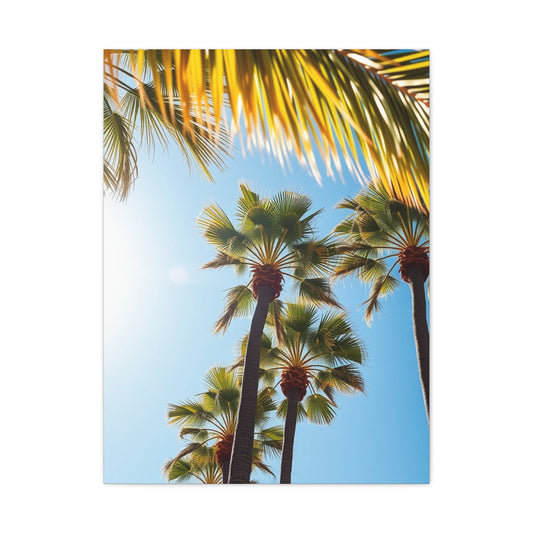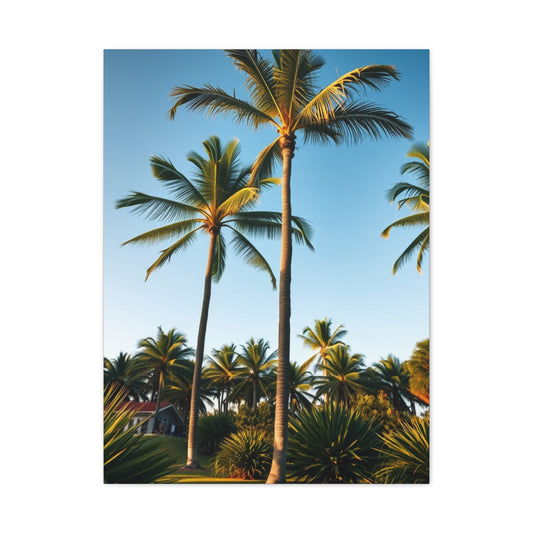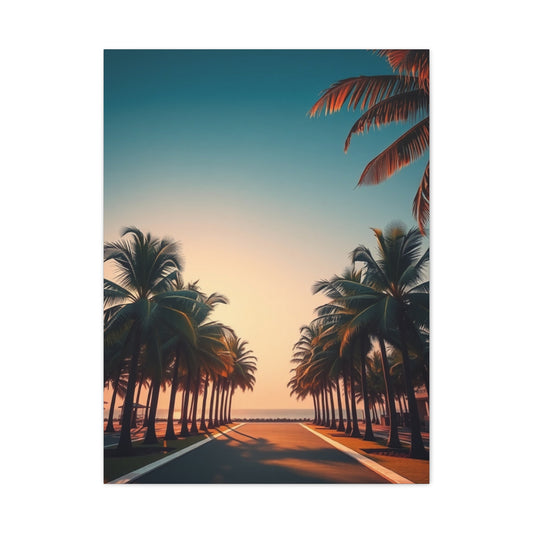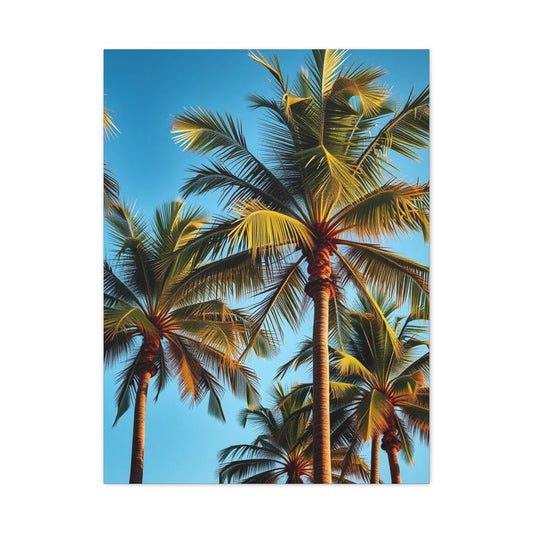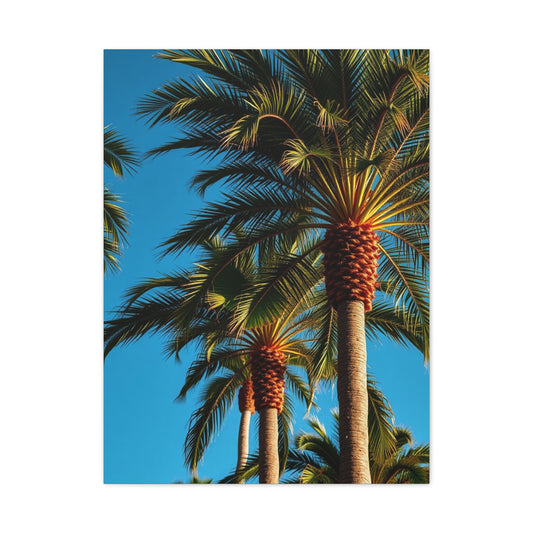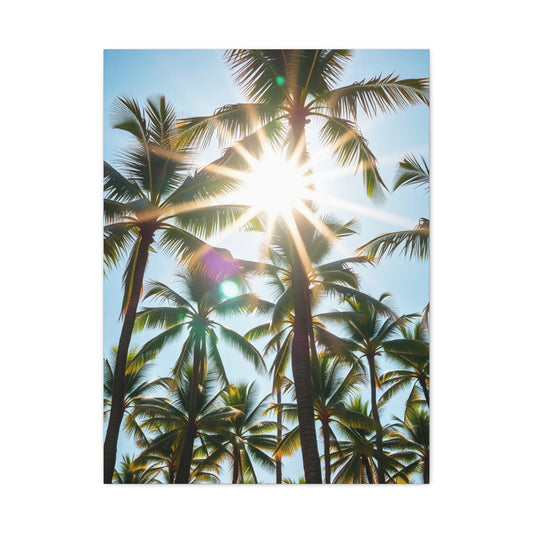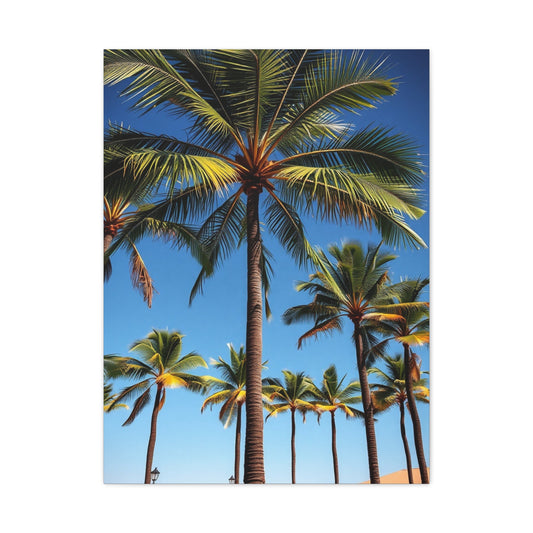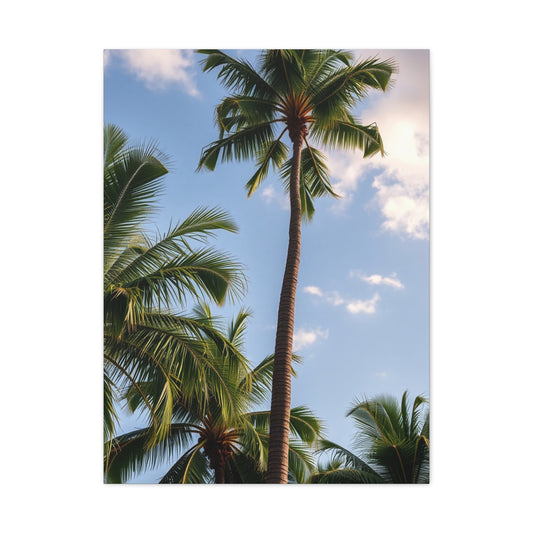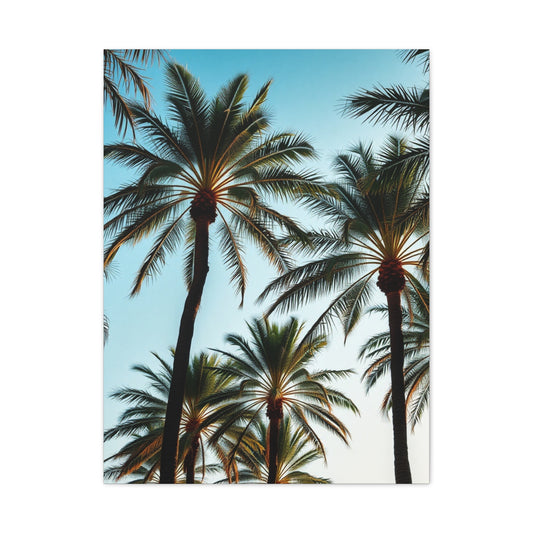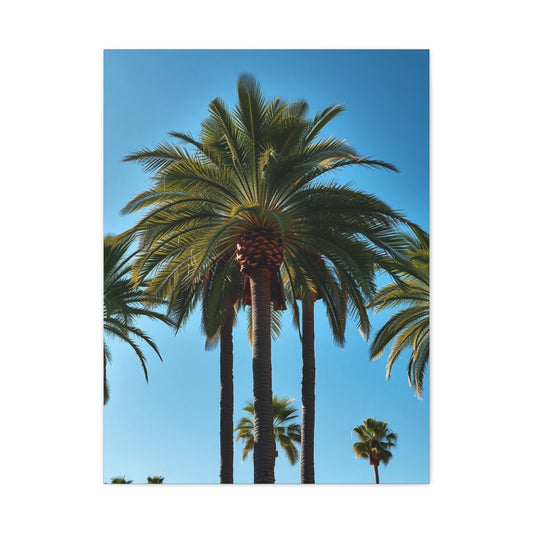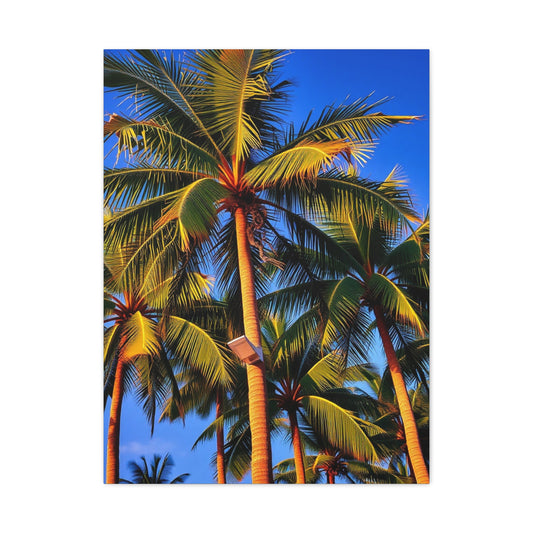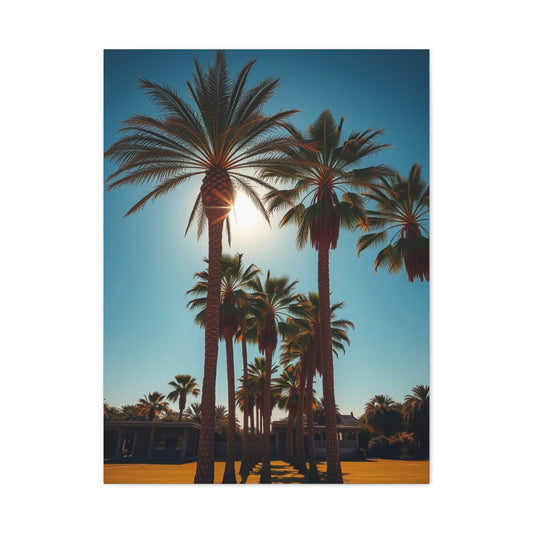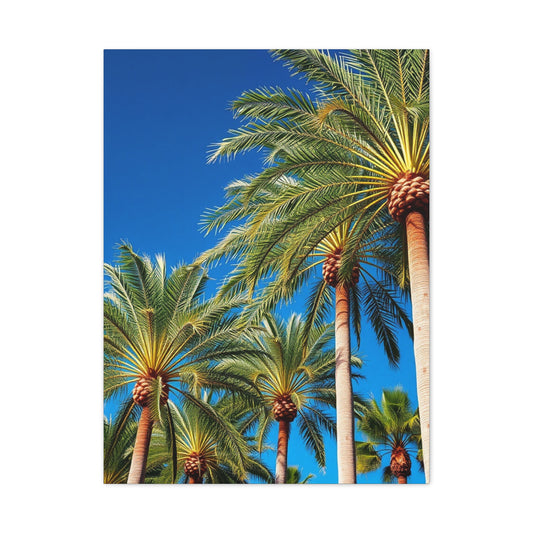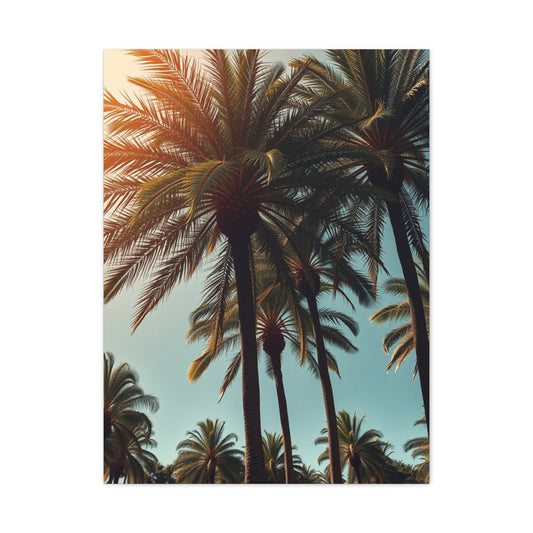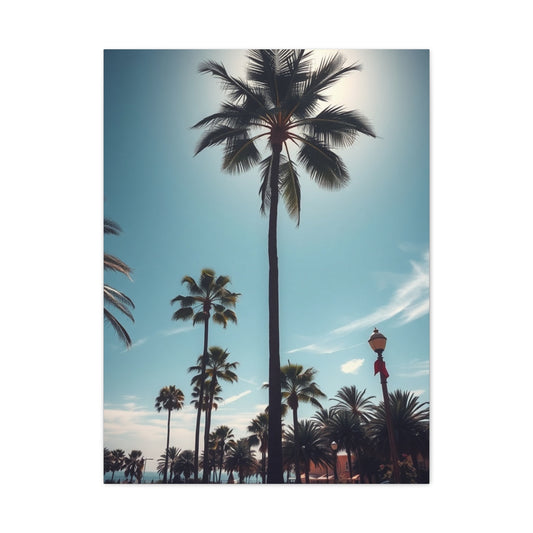Palm Tree Leaves Wall Art: Quick Decorating Inspirations for a Beachy Atmosphere
Creating a home or workspace that exudes tranquility and charm often begins with the walls. Walls set the tone for the atmosphere, and when they are thoughtfully adorned, they can instantly transport you to another place. Palm tree leaves wall decor has become a symbol of tropical serenity, weaving together freshness, vibrancy, and timeless elegance. By bringing these leafy silhouettes indoors, you recreate the feeling of ocean breezes, lush canopies, and the calm rhythm of island life.
Unlike ordinary decorations, palm-inspired wall art evokes not just beauty but also an emotional connection with nature. A single framed frond, a sprawling mural of jungle palms, or a collection of sculptural leaf motifs can transform a lifeless surface into a story of escape and adventure. What makes palm tree leaves wall decor particularly enticing is its adaptability. It can be infused into contemporary interiors, rustic beach houses, minimalist studios, or even eclectic bohemian apartments.
The fascination with palm leaves goes beyond aesthetics. They symbolize resilience, renewal, and exotic wonder. This guide explores the background, the essential design principles, the categories of palm leaf wall art, and the multitude of practical applications. By the end, you will see how palm-inspired artistry can redefine any living environment and offer a refreshing tropical charm.
Historical Background
Palm trees have always carried cultural and symbolic weight. In ancient civilizations, palm leaves were markers of victory, honor, and prosperity. The Greeks used palm fronds as emblems of triumph during athletic competitions. Romans celebrated military conquests with palm branches raised high in parades. In the Middle East, palm leaves were often linked with spiritual purity and sacred rituals. Across the tropics, indigenous communities valued palms not just as plants but as resources for shelter, weaving, and storytelling.
As trade routes expanded, the image of the palm spread across continents, and with it came new associations. During the Victorian era, palm motifs became a popular subject in decorative arts. European households and botanical conservatories embraced palm imagery as a marker of sophistication and global curiosity. The Art Deco period revived palm themes with bold geometrical patterns, turning leaves into glamorous wall adornments.
In the twentieth century, palm leaf prints became synonymous with escapism. Beach resorts, Hollywood glamour, and tropical destinations reinforced their allure. The iconic banana leaf and palm patterns that adorned wallpapers in the mid-century era were not mere fads—they reflected a yearning for relaxation, luxury, and carefree elegance. Today, palm tree leaves wall art continues this legacy, embodying a sense of both history and modernity, tradition and reinvention.
Core Concepts and Foundations
The core idea behind palm tree leaves wall decor lies in blending natural aesthetics with artistic interpretation. Palm fronds, with their linear geometry and lush arcs, possess a sculptural beauty that easily translates into visual art. When applied to walls, they create rhythm, balance, and organic flow.
One foundational concept is scale. Large-scale palm leaf wall art acts as a centerpiece, commanding attention in a room. Smaller leaf motifs, on the other hand, provide subtle accents that complement other furnishings. The second concept is medium. Palm-inspired wall decor can exist in paint, print, sculpture, textile, or even digital projection. Each medium offers a different sensory experience: painted murals feel immersive, while metallic cutouts lend a contemporary shine.
Another guiding principle is harmony with surrounding elements. Palm tree leaves harmonize naturally with earthy palettes, sandy hues, and ocean-inspired blues. Yet, when juxtaposed with modern neutrals such as gray or black, they can create a striking visual contrast. Texture plays an equally important role. Pairing palm motifs with woven rattan, bamboo accents, or raw linen establishes a cohesive tropical narrative.
Lighting must not be overlooked. A leaf-patterned wall behind soft diffused lighting creates dynamic shadows, turning static art into a living interplay of forms. Similarly, layered decor—such as combining palm leaf wallpaper with actual dried fronds mounted in frames—adds dimension and depth to a room. Ultimately, the foundation of palm leaf decor is about balance: blending vibrancy with calmness, simplicity with lushness.
Types and Categories
Palm tree leaves wall art encompasses an expansive spectrum of styles, each catering to different tastes and interior moods. Broadly, they can be divided into the following categories:
Framed botanical prints: Classic in nature, these pieces showcase palm leaves as art objects. They may feature detailed illustrations, watercolors, or even pressed, real leaves preserved under glass. They suit minimalist spaces or traditional interiors seeking an organic touch.
Murals and wallpapers: Bold and immersive, murals and wallpapers turn walls into canvases of tropical greenery. They can range from hand-painted designs to digitally printed coverings, giving rooms a sense of depth and lushness.
Sculptural and 3D art: Metal, wood, or ceramic palm leaf sculptures mounted on walls provide a tactile dimension. They create shadow play and can serve as standout statement pieces in contemporary settings.
Canvas and abstract art: Artists often reinterpret palm leaves in abstract forms, blending geometric lines or layered brushstrokes. These pieces infuse creativity while keeping the tropical theme alive.
Textile-inspired wall hangings: Woven tapestries and macrame infused with palm motifs offer a soft, artisanal quality. These often pair well with bohemian or rustic interiors.
Mixed-media installations: Combining photography, painting, and sculptural forms, mixed-media wall art brings a sense of dynamism and layered storytelling to a space.
Each category allows for personalization. Someone may prefer the sophistication of monochrome palm leaf prints, while another might lean toward flamboyant, oversized murals with vivid greens. The versatility ensures that palm tree leaves wall decor can suit both subtle accents and bold design transformations.
Practical Applications
In practice, palm tree leaves wall art can be adapted to countless spaces, from intimate alcoves to expansive great rooms. In a living room, a large canvas depicting layered palm leaves can serve as the focal point behind a sofa. Paired with natural wooden furniture, it creates an inviting, cohesive ambiance. In bedrooms, palm leaf prints in muted tones can evoke serenity and contribute to a restful atmosphere.
Hallways and entryways benefit greatly from palm-themed art, as it sets the mood upon arrival. A cluster of smaller framed prints or a slim vertical mural can elongate narrow spaces, making them feel more dynamic. Bathrooms, often overlooked, can transform into spa-like retreats with waterproof wallpaper adorned with palm patterns.
Palm tree leaves wall art also shines in outdoor and transitional spaces. Covered patios, sunrooms, or verandas become more vibrant when accented with durable wall hangings or murals inspired by palms. Offices can benefit too: palm leaf art adds warmth and creativity, counterbalancing sterile corporate environments.
For event styling, palm-inspired wall decor works brilliantly as backdrops. Weddings, tropical-themed parties, or corporate retreats often employ palm murals or hanging installations to evoke a celebratory yet relaxed tone. In hospitality settings like resorts, lounges, or beachside restaurants, palm leaf wall art reinforces the thematic identity, making guests feel instantly transported to an oasis.
The adaptability also stretches into personal creativity. With DIY approaches, individuals can craft palm art tailored to their space, whether it’s hand-painted canvases, stenciled patterns, or even repurposed dried fronds arranged into shadow boxes. The personal touch adds authenticity, making the decor not just a visual accent but a narrative piece of self-expression.
Incorporating Palm Tree Leaves into Your Decor
When weaving palm tree leaves into your decor, begin by selecting the style that best aligns with your vision. If you desire drama, oversized fronds or a sweeping mural can dominate the room, instantly setting the tone. If subtlety is the goal, delicate prints or metallic accents may be more suitable.
Framing real palm leaves in glass shadow boxes is a striking option that preserves natural beauty while protecting the delicate material. Faux fronds can be equally impactful, particularly for long-term displays, as they maintain their lush appearance without fading. For a playful yet elegant touch, arranging a trio of framed leaves in different sizes creates a gallery-like feel.
Those inclined toward a more artistic expression can consider murals. A hand-painted palm scene, perhaps depicting layered canopies or a beachside silhouette, becomes an immersive experience. Alternatively, wallpaper patterned with palms offers an easy yet transformative solution. For a contemporary twist, opt for minimalist line drawings of palm leaves in monochrome tones.
To tie the decor seamlessly with the rest of the interior, layer complementary textures. Place palm leaf wall art near woven chairs, linen cushions, or wooden side tables. Add natural fiber rugs or bamboo blinds for a cohesive tropical narrative. Lighting enhances the mood—strategically placed warm-toned lamps highlight the leaves’ details and create cozy reflections.
The versatility ensures that palm tree leaves wall art can either stand as a striking centerpiece or blend harmoniously into a layered interior story. Ultimately, the key lies in thoughtful placement and a willingness to experiment with balance.
DIY Palm Leaves Wall Art
For those who enjoy crafting, creating palm leaf wall art by hand offers both satisfaction and uniqueness. Start by painting palm leaves on canvas. Use vibrant greens, layering brushstrokes to mimic the veins and textures. A touch of gold or turquoise can enhance the exotic flair. If painting feels daunting, stencils provide a structured yet creative avenue.
Pressed palm leaves are another DIY treasure. Collect leaves, press them flat, and frame them with acid-free paper for preservation. The result is natural, organic art that brings the outside in. For a bolder project, design a wall hanging by weaving faux palm fronds with rattan or bamboo rods, creating an earthy, artisanal installation.
Wallpaper can also be approached creatively. Instead of covering an entire wall, consider cutting out sections of palm-patterned wallpaper and arranging them like oversized decals. This technique provides flexibility and avoids overwhelming a space.
For experimental souls, sculptural art using clay or papier-mâché can mimic palm fronds in three-dimensional form. Painted and mounted, these handmade creations infuse authenticity and craftsmanship. DIY palm leaves wall art not only enhances decor but also instills a personal story within your living environment.
Layering Textures and Colors
The essence of tropical-inspired interiors is the symphony of textures and colors. Palm tree leaves, with their verdant richness, invite an interplay of tones and surfaces. Earthy neutrals like sand, beige, and ivory form a calming base, while shades of green echo vitality. Pastels such as coral, blush, or mint can be woven in to add freshness.
Rattan furniture, wicker baskets, or bamboo accents work harmoniously with palm leaf art, reinforcing the natural aesthetic. Linen curtains or cotton throws amplify the breezy ambiance. To avoid monotony, introduce metallic accents like brass or copper frames around palm prints. These subtle shines add sophistication without overpowering the tropical essence.
Lighting shapes the mood profoundly. Wall sconces casting soft glows across palm leaf murals create depth, while pendant lights with woven shades echo the organic theme. Candles, strategically placed near framed palm art, add a romantic undertone during evenings.
The goal of layering is to craft a sensory tapestry. Visual appeal merges with tactile comfort, allowing palm tree leaves wall art to become part of a greater symphony of textures, colors, and emotions.
Techniques and Methods
The art of incorporating palm tree leaves into wall decor is not merely about choosing a design but about understanding the methods that breathe life into the space. Various techniques allow homeowners, designers, and artisans to translate the natural elegance of palm leaves into captivating wall art. Each approach carries its own narrative, transforming walls into both visual and tactile landscapes.
One of the most popular methods is mural painting. Murals allow an immersive experience where walls are transformed into canvases depicting lush palm groves or subtle silhouettes. Techniques can vary from freehand brushwork, which creates organic fluidity, to stenciling that ensures precision and repetition. Some artists prefer layering multiple shades of green, adding touches of gold, or even blending watercolor washes to mimic the delicate translucence of real leaves. Murals often become conversation pieces because they not only decorate but also envelop the viewer in an atmosphere of tropical vitality.
Wallpaper design is another widely embraced method. Digitally printed wallpapers make it possible to capture intricate details of palm leaves in high resolution, bringing hyper-realism into interiors. Others opt for abstract or stylized palm motifs, where the focus lies in bold outlines, geometric patterns, or subdued tonal palettes. Installation techniques have advanced, making peel-and-stick options convenient for temporary yet transformative decor.
Sculptural wall art offers a three-dimensional approach. Artisans craft palm leaves out of metal, wood, clay, or resin, giving depth and shadow to otherwise flat walls. The technique of metal embossing, where sheets of brass or copper are molded into leaf forms, produces a luxurious, textured finish. Wooden carvings highlight the natural veins of palm leaves, while ceramic or resin replicas lend durability and sophistication.
Framing real palm leaves is a method rooted in preservation. The leaves are carefully pressed, dried, and mounted behind glass. This technique allows nature itself to become the artwork, offering authenticity and a direct connection to the outdoors. Some decorators experiment by painting over dried leaves, creating hybrid pieces that merge nature and artistry.
Textile-based wall hangings provide a softer touch. Techniques such as weaving, macrame, or embroidery incorporate palm leaf motifs into tapestries or fabric panels. These pieces add warmth and craftsmanship, ideal for bohemian or rustic interiors. Modern methods also include digital projection art, where palm leaves are animated through light and projected on walls, adding a futuristic layer to the tropical aesthetic.
Ultimately, the chosen method depends on the desired mood. Some prefer minimal elegance with monochrome leaf outlines, while others pursue maximalism through oversized, flamboyant murals. The technique is the bridge between imagination and execution, allowing palm tree leaves to transcend their natural form and become lasting artistic impressions.
Challenges and Common Mistakes
While palm tree leaves wall art has immense potential, some challenges and pitfalls often hinder the outcome. One of the most common mistakes is over-saturation. Filling every wall with palm motifs can overwhelm the space, making it feel chaotic rather than tranquil. Palm leaf decor thrives when balanced with neutral areas, allowing the artwork to breathe and be appreciated in harmony with its surroundings.
Scale is another recurring issue. Oversized murals in small rooms can shrink the perception of space, while tiny prints in expansive walls may appear insignificant. Choosing the right scale requires a keen understanding of proportion and spatial awareness. A large palm leaf mural might look stunning in a spacious living room, but could feel stifling in a compact bedroom.
Color misuse can also disrupt the intended ambiance. While palm leaves are naturally green, relying only on bright greens may limit the decor’s versatility. Muted tones, gradients, or monochrome versions often work better in minimalist or modern settings. Overly saturated colors may clash with existing furniture or textiles, leading to visual dissonance.
Texture imbalance is another mistake. Palm motifs pair beautifully with organic materials such as wood, linen, or rattan. However, combining them with synthetic, glossy, or overly industrial finishes can diminish their natural charm. The decor should feel cohesive, not disjointed.
Lighting is frequently overlooked. Without proper illumination, the textures and details of palm wall art may appear flat. Direct harsh light may cause glare on framed pieces, while inadequate lighting may reduce the depth of murals or sculptures. The solution lies in using layered lighting that enhances the subtleties of palm textures while maintaining a soft, inviting glow.
Maintenance challenges also exist. Real dried palm leaves can be fragile, prone to fading, or affected by humidity. In such cases, preservation techniques such as UV-resistant glass or climate control become necessary. Wallpapers may peel in humid environments, requiring careful consideration of location.
Another common pitfall is ignoring context. Palm leaves evoke tropical vibes, but when placed in settings that conflict with this narrative, they can appear out of place. For instance, a heavily industrial loft may require a more stylized or abstract palm motif rather than hyper-realistic fronds. Similarly, traditional interiors may need subtle prints instead of bold murals.
Lastly, the mistake of neglecting personal connection often weakens the decor. Palm tree leaves wall art should not merely follow a trend but should reflect the individual’s story, taste, and sense of place. When decor feels forced, it loses its soul. Approaching palm-inspired art with intention ensures it resonates not just visually but emotionally.
Trends and Future Outlook
Design is ever-evolving, and palm tree leaves wall art is no exception. The current landscape reveals a fascinating blend of tradition, innovation, and sustainability. One dominant trend is the move toward oversized botanical murals. These expansive artworks cover entire walls, creating immersive environments reminiscent of tropical jungles or serene coastal escapes. Instead of small accents, homeowners now embrace bold statements that blur the line between art and environment.
Monochrome palm art has also surged in popularity. Black-and-white prints, minimal line drawings, and grayscale murals offer sophistication while maintaining the organic charm of palm motifs. This trend caters to modern and minimalist spaces, proving that tropical themes can be adapted to diverse aesthetics.
Another emerging trend is the fusion of palm leaves with metallic finishes. Gold, silver, and bronze accents highlight veins and contours, adding glamour to an otherwise natural motif. Metallic palm sculptures or prints with shimmering details strike a balance between nature and luxury.
Sustainability plays a significant role in the future of palm-inspired decor. Eco-conscious consumers seek wall art crafted from recycled materials, natural fibers, or ethically sourced wood. Artists are experimenting with organic dyes, biodegradable wallpapers, and even upcycled palm fronds to reduce environmental impact. This trend not only adds authenticity but also aligns with the values of a growing eco-aware generation.
Digital art and technology are shaping the future as well. Projection mapping and augmented reality allow interactive palm-themed installations. Imagine walls where palm leaves sway gently with a breeze simulated by projection, or wallpapers that shift tones depending on the time of day. These innovations merge tropical nostalgia with futuristic experiences.
Customization is another trajectory. With advancements in printing technology, homeowners can now create personalized palm leaf wall art tailored to their exact preferences. Whether it’s replicating leaves from a memorable vacation or designing bespoke murals to match a color palette, individuality drives the trend forward.
The fusion of global influences continues to enrich palm decor. Tropical motifs are now combined with African patterns, Asian brushwork, or Latin American vibrancy, creating cross-cultural aesthetics. This hybridity reflects the interconnectedness of the modern world while celebrating local traditions.
Looking ahead, the future of palm tree leaves wall art lies in adaptability. It will no longer be confined to static prints but will expand into dynamic experiences that blend art, sustainability, and technology. The timeless charm of palm leaves ensures their continued presence, but the interpretations will evolve, offering endless possibilities for creative exploration.
Expert Insights
Experts in interior design, art, and cultural history provide valuable perspectives on the enduring appeal of palm tree leaves in wall decor. Designers often highlight the psychological impact of tropical motifs. Palm leaves evoke feelings of calm, relaxation, and rejuvenation, which is why they are frequently used in wellness spaces, spas, and retreats. Their organic shapes break the rigidity of urban interiors, adding softness and fluidity.
Art historians trace the motif’s longevity to its symbolic resonance. Palm leaves have represented victory, fertility, and paradise across cultures for millennia. This deep-rooted symbolism ensures their relevance across time, giving palm-inspired art a universal appeal that transcends fleeting trends.
From a craftsmanship perspective, artisans emphasize the versatility of palm motifs. Whether carved, painted, or woven, the leaf’s geometry offers endless design opportunities. Metalworkers find inspiration in the intricate veins, while painters experiment with gradients and translucence. The leaf’s adaptability ensures that it can be both understated and flamboyant, traditional and modern.
Environmental experts caution about the importance of sustainability in palm-themed decor. The rising demand for natural materials must be balanced with ecological responsibility. They advocate for sourcing from renewable resources, using eco-friendly finishes, and opting for faux alternatives when necessary. Ethical craftsmanship ensures that the decor not only beautifies spaces but also respects the planet.
Interior stylists often recommend moderation and context. Palm wall art should complement the room’s narrative rather than dictate it. A seasoned designer might suggest a subtle monochrome palm print for a minimalist loft, while encouraging a vibrant mural for a beach house. The insight lies in reading the space and aligning the motif with the environment.
Artists also stress the importance of personal expression. Palm leaves can be a canvas for individuality. Whether through DIY projects or commissioned art, integrating personal experiences—such as palm fronds from a meaningful journey—adds authenticity. This personal touch distinguishes mere decoration from soulful design.
Collectively, these expert insights underline the enduring charm of palm tree leaf wall art. Its ability to merge history, psychology, artistry, and sustainability ensures that it remains not only a decorative choice but also a meaningful design philosophy.
Emerging Trends in Wall Art
Wall art has always mirrored cultural shifts, lifestyle preferences, and technological advances. In recent years, there has been a remarkable transformation in how people use wall decor to articulate personality, mood, and even philosophy. Palm tree leaves wall art, being both timeless and versatile, continues to evolve with these broader movements in design.
One prominent trend is the rise of immersive environments. Instead of merely hanging a framed print, homeowners now embrace panoramic murals and wraparound wallpapers that envelope entire rooms. Palm leaf motifs stretching across multiple walls create a sanctuary-like atmosphere, where the viewer feels transported into a lush grove rather than just observing a decorative element. This immersive style is popular in both residential and hospitality spaces, especially resorts and boutique hotels seeking to replicate a tropical retreat indoors.
Minimalist adaptations of tropical motifs also define the current aesthetic landscape. Instead of flamboyant fronds in saturated greens, stylized monochrome line drawings or neutral-toned silhouettes are gaining attention. These designs blend the organic elegance of palms with the restraint of modern minimalism, making them suitable for urban apartments, lofts, and office spaces where understated sophistication is valued.
Another fascinating development is the integration of mixed materials. Palm leaves are being reimagined through layered textures: embossed leather panels, metallic wall sculptures, or even reclaimed wooden carvings. This multi-sensory approach not only adds visual intrigue but also offers tactile richness, making walls come alive with depth and character.
Sustainability remains a dominant driver in wall decor trends. Eco-conscious consumers are increasingly demanding artwork crafted from natural, renewable, or recycled materials. Palm tree leaves wall art made from bamboo fiber, handwoven textiles, or upcycled materials resonates with both aesthetics and ethics. Designers are also experimenting with eco-friendly printing methods and biodegradable wallpapers to align beauty with responsibility.
Technology has introduced dynamic dimensions to traditional wall art. Digital projections of palm leaves swaying in an imaginary breeze or augmented reality applications that let users visualize palm motifs in different styles before installation illustrate how technology is reshaping decor. Such innovations create interactive experiences that move beyond static visuals.
Customization also continues to grow. With digital printing advancements, individuals can create personalized palm-inspired designs tailored to exact wall dimensions, color palettes, or even specific memories. Some homeowners replicate palm fronds from travels or use photographic prints of actual leaves they have collected, turning wall decor into a personal narrative rather than generic art.
The merging of global influences further enriches palm-themed art. Designers draw inspiration from African patterns, Asian brushwork, or South American vibrancy, infusing palm leaves with hybrid aesthetics. This cultural cross-pollination reflects an interconnected world while ensuring that palm motifs remain fresh and relevant.
Altogether, the emerging trends suggest a shift toward experiential, sustainable, and personalized wall art. Palm tree leaves remain central within this evolution, effortlessly adapting to new media and cultural narratives.
Step-by-Step Guides
Creating a Palm Leaf Mural
-
Conceptualize the design: Begin by choosing the scale of your mural. Decide whether you want a realistic jungle canopy effect or an abstract silhouette. Sketch rough drafts on paper to visualize placement.
-
Prepare the wall: Smooth out imperfections by sanding and applying primer. A clean base ensures vibrant colors and longevity.
-
Outline the leaves: Lightly sketch leaf shapes with a pencil or use stencils for symmetry. For freehand painting, mark main veins and arcs to guide brushwork.
-
Layer the colors: Start with a base green, then layer lighter and darker shades to mimic depth. Blend edges to create natural gradients. Accents of gold or blue can add exotic flair.
-
Add finishing touches: Highlight veins with a fine brush. Use a damp sponge to soften edges for a watercolor effect or sharp lines for a modern look.
-
Seal the mural: Apply a clear matte finish to protect against dust, moisture, or fading.
Designing with Wallpaper
-
Measure the space: Accurate measurements are crucial for ensuring seamless patterns without awkward cut-offs.
-
Select the pattern: Choose between hyper-realistic palm prints, stylized line motifs, or bold graphic leaves depending on the room’s mood.
-
Prepare the wall surface: Remove old paint chips, smooth uneven areas, and apply a primer designed for wallpaper.
-
Apply the wallpaper: Begin at the center of the wall for symmetry. Align patterns carefully, smoothing each section to prevent air bubbles.
-
Trim edges and finish: Use a sharp blade for clean edges along corners and baseboards.
Crafting Framed Palm Leaf Art
-
Choose the leaves: Collect real fronds or purchase faux replicas, depending on durability needs. Ensure they are dried or pressed for framing.
-
Prepare the backing: Use acid-free paper or fabric to mount the leaf. Neutral colors like ivory or beige emphasize natural textures.
-
Position the leaf: Experiment with angles before fixing it in place. A central position creates formality, while diagonal placement feels dynamic.
-
Frame under glass: Select frames with UV-protective glass to prevent fading. Wooden or bamboo frames complement the tropical essence.
-
Arrange in series: Hanging multiple frames of varying leaf sizes creates a cohesive gallery wall effect.
Sculptural Palm Wall Art
-
Select the material: Metals like brass or aluminum, or wood such as teak or mahogany, are ideal for durable sculptures.
-
Design the form: Sketch dimensions, considering both proportion and wall space.
-
Craft or purchase the sculpture: Skilled artisans can hand-carve or emboss palm leaves, while pre-made designs are available for convenience.
-
Mount securely: Sculptural art requires sturdy fixtures. Use wall anchors to support weight and prevent accidents.
-
Enhance with lighting: Install directional lighting to cast dramatic shadows, accentuating the contours of the leaf.
DIY Palm Leaf Canvas
-
Gather materials: Canvas, acrylic paints, brushes, and a palette.
-
Sketch outlines: Lightly mark palm fronds in desired positions.
-
Paint base layer: Apply background colors first, such as sandy beige or oceanic blue.
-
Build leaf layers: Use a mix of green shades, layering strokes to mimic veins.
-
Highlight and finish: Add subtle metallic highlights or shadow accents. Once dry, frame or hang directly.
Weaving a Palm-Inspired Tapestry
-
Select fibers: Use jute, hemp, or cotton threads for authenticity.
-
Create the base: Use a loom or wooden frame to establish the weaving foundation.
-
Integrate motifs: Weave palm leaf shapes into the tapestry using contrasting thread colors.
-
Finish the piece: Add fringes or tassels for artisanal character.
-
Mount on a rod: Display as a hanging wall panel that introduces texture and warmth.
Blending Palm Art with Lighting
-
Position art strategically: Place palm murals or sculptures where natural or artificial light enhances details.
-
Use warm tones: Lighting with golden hues complements tropical aesthetics.
-
Layer light sources: Combine overhead, accent, and ambient lights to highlight textures and create depth.
-
Experiment with shadows: Sculptural palms look especially dynamic when shadows mimic natural foliage patterns.
Emerging trends and step-by-step techniques reveal how palm tree leaves wall art has transformed from a simple decorative element into a versatile design language. Whether through murals that engulf entire rooms, sustainable wallpapers, sculptural accents, or handcrafted DIY creations, palms continue to adapt across styles and generations. The appeal lies not only in their visual grace but in the mood they evoke—relaxation, vitality, and an enduring connection with nature.
By experimenting with different methods, avoiding common pitfalls, and embracing both traditional and futuristic approaches, decorators and homeowners can create personalized sanctuaries. Palm tree leaves wall art is no longer confined to tropical resorts; it has become a universal design tool, capable of enriching modern city lofts, serene cottages, and sophisticated offices alike.
Advanced Styling Approaches
The art of decorating walls with palm tree leaves evolves when advanced styling approaches are introduced. Beyond the fundamental ideas of murals, wallpapers, and framed leaves lies a realm of more sophisticated techniques that merge artistry with subtlety. These approaches are especially useful for those who seek to create not just decorative displays but immersive atmospheres layered with nuance.
One advanced method is the concept of layered installations. Instead of focusing on a single artwork, multiple forms of palm-inspired decor are combined to form a cohesive arrangement. For example, a mural might serve as the backdrop while sculptural metallic leaves are mounted in the foreground, producing an interplay of two- and three-dimensional forms. This layering produces depth and evokes the sensation of stepping into a tropical grove.
Another refined approach is color modulation. Rather than using pure green tones, stylists often experiment with gradients, muted palettes, or contrasting shades to reinvent the familiar form of palm fronds. Soft pastels such as blush or lavender layered with olive tones create a dreamlike quality, while darker hues like emerald paired with deep indigo establish a moody, dramatic setting. This experimentation allows palm tree leaves wall art to transcend its natural coloration and become a tool for mood design.
Texture amplification is another powerful method. While murals and wallpapers provide visual rhythm, adding tactile elements such as woven panels, embossed leather, or carved wood introduces touch into the equation. When palms are reinterpreted in different materials, they shift from being mere images to multisensory experiences.
A sophisticated technique also involves narrative integration. Instead of treating palm leaf art as decoration, designers weave stories into the arrangement. A mural might depict not just leaves but a scene that suggests movement, light, and the passage of time, making the decor a silent storyteller. In some homes, palm art is paired with photographs, heirlooms, or travel memorabilia, creating a layered story that feels personal and authentic.
Finally, advanced styling often uses spatial harmony. By aligning palm motifs with architectural features such as arched windows, vaulted ceilings, or stairwell walls, the decor feels intentional rather than ornamental. This approach underscores the ability of palm-inspired art to not just fill walls but to highlight the architecture of a room itself.
Cultural Symbolism and Deeper Meanings
The significance of palm leaves extends far beyond design. Across civilizations, they have been seen as emblems of life, resilience, and victory. Infusing this symbolism into wall art enriches interiors with subtle depth.
In ancient Mesopotamia, palms symbolized fertility and abundance. Their imagery adorned temples and manuscripts, marking them as sacred. In Greece and Rome, palm branches celebrated triumph and were used in ceremonies for champions and victorious soldiers. In Christian iconography, palm leaves represented peace and eternal life.
In tropical regions, palms have long served as essential resources for survival. They provided shelter, nourishment, and crafting materials, which explains why their leaves became visual metaphors for sustenance and harmony with nature. For island communities, palms are interwoven with folklore and ancestral traditions, representing continuity and cultural identity.
When integrated into modern wall art, these symbolic meanings linger quietly. A palm leaf mural in a meditation room might signify peace and balance, while metallic palm sculptures in a living room might whisper triumph and resilience. For many, palm-inspired art is not only about aesthetics but also about honoring universal archetypes of renewal and victory.
By appreciating these layers of meaning, homeowners and designers can use palm tree leaves wall art not only to beautify but also to infuse spaces with cultural resonance.
Psychological Impact of Palm-Inspired Interiors
The psychological influence of palm motifs in interiors is profound. Humans respond instinctively to natural imagery, a concept rooted in biophilia, the innate tendency to seek connection with nature. Palm leaves, with their flowing arcs and rhythmic patterns, evoke feelings of relaxation, calm, and rejuvenation.
Studies in environmental psychology suggest that exposure to nature-inspired imagery reduces stress and enhances well-being. Palm leaf wall art creates a sense of openness, mimicking the expansiveness of tropical landscapes. In small apartments or urban offices, this imagery provides an antidote to confinement, allowing the mind to wander to breezy shores and tranquil groves.
The rhythmic repetition of palm fronds also has a meditative quality. Unlike chaotic patterns, their symmetry creates a visual order that encourages mental clarity. When paired with soft lighting and earthy tones, palm leaf decor contributes to an environment conducive to mindfulness and focus.
For hospitality and wellness spaces, palm tree leaf wall art becomes more than design; it becomes therapy. Spas, yoga studios, and retreats use palm motifs to evoke serenity and rejuvenation, reinforcing the psychological connection between visual environments and emotional states.
Global Adaptations and Regional Variations
Palm tree leaves may be globally recognized, but their artistic interpretations differ across cultures. In the Caribbean, wall art often embraces vibrant colors, reflecting the exuberance of local life and natural surroundings. Murals in bold turquoise, crimson, and lime green create a celebratory atmosphere.
In Southeast Asia, palm-inspired wall art often leans toward spiritual symbolism. Stylized palm leaves might appear in temple murals or as motifs in traditional textiles adapted into wall hangings. These representations highlight not just aesthetics but sacred cultural narratives.
Middle Eastern adaptations lean toward geometric abstraction. Here, palm fronds are stylized into symmetrical patterns reminiscent of traditional architectural ornamentation. This stylization connects palm imagery with ideas of order, infinity, and divine beauty.
In contemporary Western settings, palm leaves are frequently interpreted through minimalism or modernism. Black-and-white prints, abstract silhouettes, or metallic sculptures align with clean lines and uncluttered interiors, allowing the palm motif to adapt seamlessly to contemporary tastes.
These regional variations illustrate how a universal natural form takes on diverse expressions. By drawing inspiration from global traditions, decorators can enrich palm tree leaves wall art with cultural hybridity, adding originality and resonance.
Future Evolution of Palm Wall Decor
Looking forward, palm tree leaves wall art is poised to evolve in directions shaped by sustainability, technology, and personalization. The growing demand for eco-conscious living will likely drive innovations such as biodegradable wallpapers, plant-based dyes, and upcycled palm frond art. This ensures that the beauty of palms is preserved without environmental compromise.
Technology promises exciting transformations. Augmented reality will allow homeowners to preview palm motifs in different scales and styles before installation. Interactive projections may create dynamic environments where palm leaves sway or change hues with ambient sound or time of day. Such advances will redefine the relationship between art and viewer, shifting from static admiration to dynamic engagement.
Personalization will also dominate future trends. Homeowners increasingly seek decor that reflects individual stories. Palm leaves collected from travels, digitally transformed into custom wallpapers or framed art, will become more accessible through advanced printing technologies. This shift from generic to bespoke ensures that wall art carries not just beauty but personal meaning.
As global design continues to blend influences, palm motifs will likely fuse with other cultural symbols, creating hybrid aesthetics. A mural might pair palm leaves with geometric African patterns, or a sculpture might integrate Asian brushstroke techniques. This hybridity will keep palm-inspired art fresh while reflecting the interconnected world.
The future promises not just continuity but reinvention, ensuring palm tree leaves remain enduring yet adaptable emblems in the design landscape.
Practical Tips for Homeowners and Designers
For individuals eager to incorporate palm tree leaf wall art effectively, a few practical strategies can enhance results. Begin with moderation. Choose one or two focal points rather than filling every surface with palm motifs. This ensures balance and avoids visual saturation.
Pay attention to scale. Large palm murals are ideal for spacious living rooms, while smaller framed prints or tapestries suit compact bedrooms or hallways. Matching scale to space creates harmony.
Experiment with color palettes. While greens are traditional, muted tones, metallic finishes, or monochrome designs can adapt palms to various interior themes. Allow the color to complement existing furniture and textiles.
Layer textures for depth. Combine palm wall art with rattan chairs, linen curtains, or bamboo blinds to create a cohesive tropical story. Integrating natural materials enhances the authenticity of the aesthetic.
Lighting remains critical. Use warm ambient lights to highlight palm motifs and prevent them from appearing flat. Directional lights can create shadows that mimic natural foliage, adding dynamism.
Above all, personalize the approach. Whether by creating DIY projects, commissioning an artist, or integrating travel mementos, ensure the decor reflects your story. Palm wall art should not feel generic but intimately tied to your vision.
Conclusion
Palm tree leaves wall art represents far more than a decorative trend. It is a bridge between nature and human spaces, a canvas that carries cultural history, psychological resonance, and artistic versatility. From ancient symbolism to modern innovation, palms have endured as emblems of vitality, peace, and beauty.
Across parts one through four, we explored their historical background, foundational principles, methods of execution, challenges to avoid, trends shaping the present, and visions of the future. We examined their cultural symbolism, psychological effects, global variations, and advanced styling techniques. What emerges is a comprehensive understanding: palm tree leaves wall art is both timeless and transformative.
Whether it is through immersive murals, framed fronds, sculptural masterpieces, or sustainable digital projections, palms continue to redefine spaces with tropical vitality. They offer not just visual charm but emotional connection, reminding us of breezes, open skies, and the serenity of nature.
In a world increasingly defined by speed and artificiality, palm-inspired wall art stands as a gentle reminder of rhythm, resilience, and tranquility. Its adaptability ensures relevance in diverse settings, from minimalist lofts to island retreats, from traditional homes to futuristic interiors.
The conclusion is simple yet profound: palm tree leaves wall art is not merely decoration, but a philosophy of living. It invites us to breathe, to embrace nature’s elegance, and to create spaces that nurture both body and spirit. Its future will evolve, but its essence will remain eternal—an enduring symbol of harmony, beauty, and tropical bliss.

